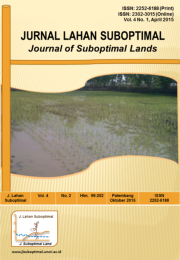Preferensi Petani di Lahan Rawa Lebak Sumatera Selatan Terhadap Padi Varietas Unggul Baru (VUB) Hasil Litbang Pertanian (Studi Kasus: Poktan Sinar Sakti Desa Lubuk Sakti Kecamatan Indralaya Kabupaten Ogan Ilir)
DOI:
https://doi.org/10.33230/JLSO.4.2.2015.161Keywords:
New varieties, preference, riceAbstract
The dissemination of new varieties produced Agricultural Research are usually constrained by farmer preference at the farm level. The level of preferences determined the admissibility of a high-yielding varieties those were introduced. The study of preference was conducted in Lubuk Sakti village, Indralaya District, Ogan Ilir Regency, South Sumatra from April until August 2013. The location is the location of the demonstration plot studies testing new varieties (VUB) Agricultural Research results. Preference test conducted on rice and rice from Ciherang, Inpari 10, Inpari Inpari 12 and 14. Respondents consisted of 20 farmers who are members of farmer groups Rays Way. Parameter assessment consists of rice appearance, color and aroma while the rice is composed of taste, color, texture and aroma. As for the scale for the assessment of rice and rice namely: (1) Very dislike, (2) Dislike, (3) Somewhat Like, (4) Like and (5) Very Like it. The results showed that Inpari 10, Inpari 14 and Ciherang has the potential to be developed in the swampy marsh areas have a preference for rice and rice were good enough that somewhatlike to like. Most farmers in the swampy wetlands preferred rice varieties have furnished (rice fluffier texture).Downloads
Published
2016-11-14
How to Cite
Somantri, R. U., & Syahri, S. (2016). Preferensi Petani di Lahan Rawa Lebak Sumatera Selatan Terhadap Padi Varietas Unggul Baru (VUB) Hasil Litbang Pertanian (Studi Kasus: Poktan Sinar Sakti Desa Lubuk Sakti Kecamatan Indralaya Kabupaten Ogan Ilir). Jurnal Lahan Suboptimal : Journal of Suboptimal Lands, 4(2), 142–150. https://doi.org/10.33230/JLSO.4.2.2015.161
Issue
Section
Articles
License
Copyright (c) 2016 Renny Utami Somantri, Syahri Syahri

This work is licensed under a Creative Commons Attribution-NonCommercial-ShareAlike 4.0 International License.













